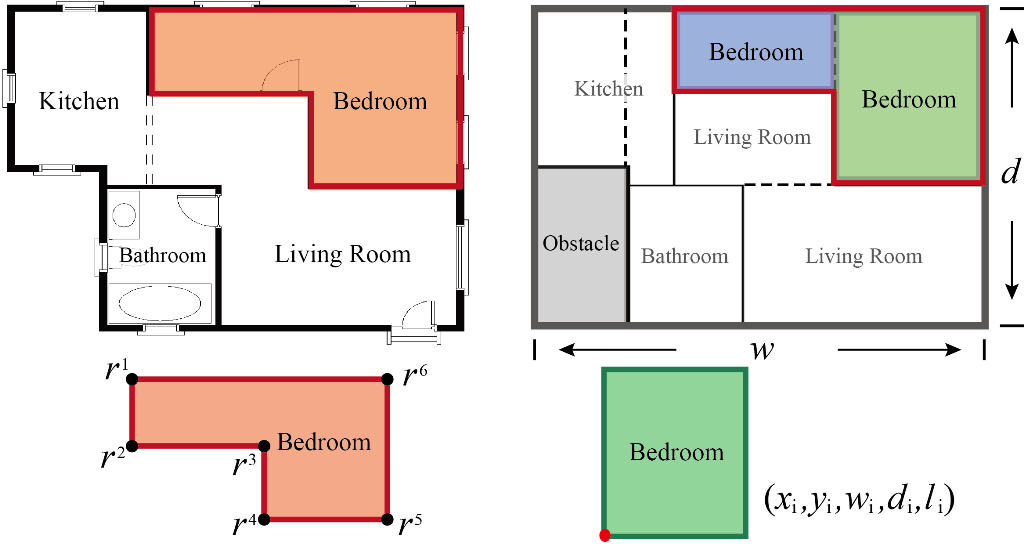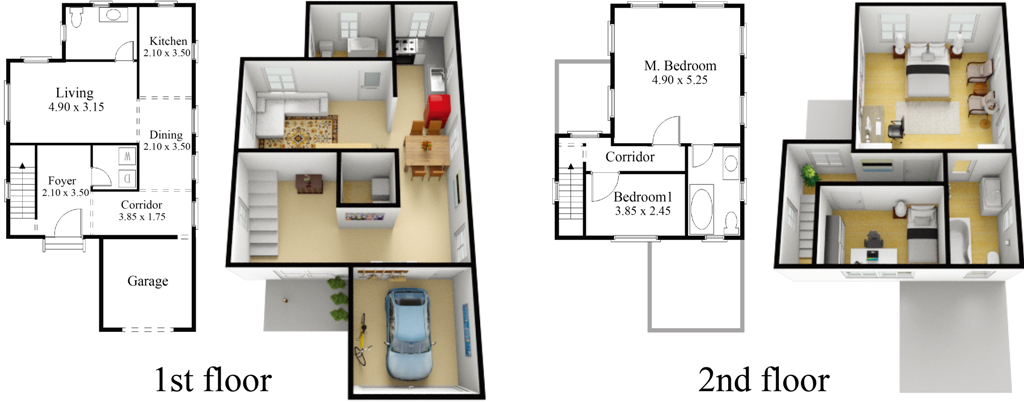|
MIQP-based Layout Design for Building Interiors
Computer Graphics Forum,
37(2), 2018
|
|||||||||||||||
|
|
|||||||||||||||
|
Teaser: We propose a framework that generates building interiors with high-level constraints, e.g., room size, room position, room adjacency, and the outline of the building. (a) The layout of a two-storey house and corresponding 3D renderings. (b) A large-scale exampledepicting an office building. For such large-scale layouts, our method is faster by multiple orders of magnitude than previous methods.
|
|||||||||||||||
| Abstract | We propose a hierarchical framework for the generation of building interiors. Our solution is based on a mixed integer quadratic programming (MIQP) formulation. We parametrize a layout by polygons that are further decomposed into small rectangles. We identify important high-level constraints, such as room size, room position, room adjacency, and the outline of the building, and formulate them in a way that is compatible with MIQP and the problem parametrization. We also propose a hierarchical framework to improve the scalability of the approach. We demonstrate that our algorithm can be used for residential building layouts and can be scaled up to large layouts such as office buildings, shopping malls, and supermarkets. We show that our method is faster by multiple orders of magnitude than previous methods. | ||||||||||||||
| Keywords |
Architectural modeling, Spatial allocation, Integer Programming
|
||||||||||||||
| Motivation |
The process of designing interior layouts of buildings is quite complicated and time-consuming. Since designers have to generate a valid layout that fulfills some hard constraints and also a set of high-level constraints, e.g., room size, room position, and etc. The design process is a trial-and-error process in which designers have to combine intuition, prior experience, and professional knowledge. It usually takes from several days to a couple of weeks or even much longer. How to design interior layouts of buildings automatically is an interesting research topic. There are two main challenges. First, how to present the interior layout and abstract a set of constraints according to the definition is difficult. Second, applying current methods to a large-scale layout design problem is not easy. A new framework is needed for synthesizing large layouts. |
||||||||||||||
| Concept |
An interior layout consists of four rooms, i.e., living room, bedroom, bathroom, and kitchen. Left: each room is represented as an axis-aligned polygon defined by points. Right: the layout is presented by a set of room rectangles by decomposing the polygonal room into small rectangles with the same label. The layout domain is presented as the bounding box of the domain subtracted by obstacle rooms shown in gray. |
||||||||||||||
| Method |
Overview of our framework. Given a list of high-level constraints and an outline as input (Input), we compute a layout using a hierarchical framework. Level 1 shows an initial layout and Level 2 shows the layout including local refinements. Finally, additional details can be added to visualize the results as architectural floorplans or 3D models.
Pipeline of the hierarchical framework. (a) Starting from the empty layout domain with the door position and two obstacles, our method generates (b) an interior layout on the first level according to the user-specified high-level constraints. There is a region (shown in red) that is not covered by any room. (c) Our algorithm automatically selects the sub-domain (highlighted as the red polygon) for the optimization on the next level. (d) Then, the sub-domain is initialized with small rectangles and constraints are updated. (e) The new layout is generated in the sub-domain (i.e.,red polygon). The user specifies the study room (blue rectangle) for further improvement. (f) The final result.
An interior layout of a shopping mall is generated by our hierarchical framework. (a) Starting from an empty layout domain with obstacles. (b) First, we generate the layouts for five regions shown in different colors. (c) Then aisles are generated by expanding the gap between two regions with a fixed width. (d) Next, we generate the layouts inside each region. (e-h) We repeat this procedure to get (i) the final layout. The number of objects (regions and rooms) and constraints on each level are specified by the user.
An interior layout of a bungalow-style house generated by our algorithm. The floorplan is shown in the middle. Two sides of the 3D rendering are shown.
An interior layout of a two-storey house. The stairs are considered as special rooms that should be consistent between two floors. The floorplan of each floor is shown on the left, 3D renderings are shown on the right.
Interior layouts of supermarkets generated by our method. Shelves for products in the same category are in the same color.
This work was supported by the KAUST Office of Sponsored Research (OSR) under Award No. OCRF-2014-CGR3-62140401, and the Visual Computing Center at KAUST. Ligang Liu is supported by the National Natural Science Foundation of China (61672482, 61672481, 11626253) and the One Hundred Talent Project of the Chinese Academy of Sciences. We would like to thank Virginia Unkefer for proofreading the paper. | ||||||||||||||
| Copyright and disclaimer: The SOFTWARE provided at this page is provided "as is", without any guarantee made as to its suitability or fitness for any particular use. It may contain bugs, so use of this tool is at your own risk. We take no responsibility for any damage that may unintentionally be caused through its use. |
| Copyright © 2018 GCL , USTC |







